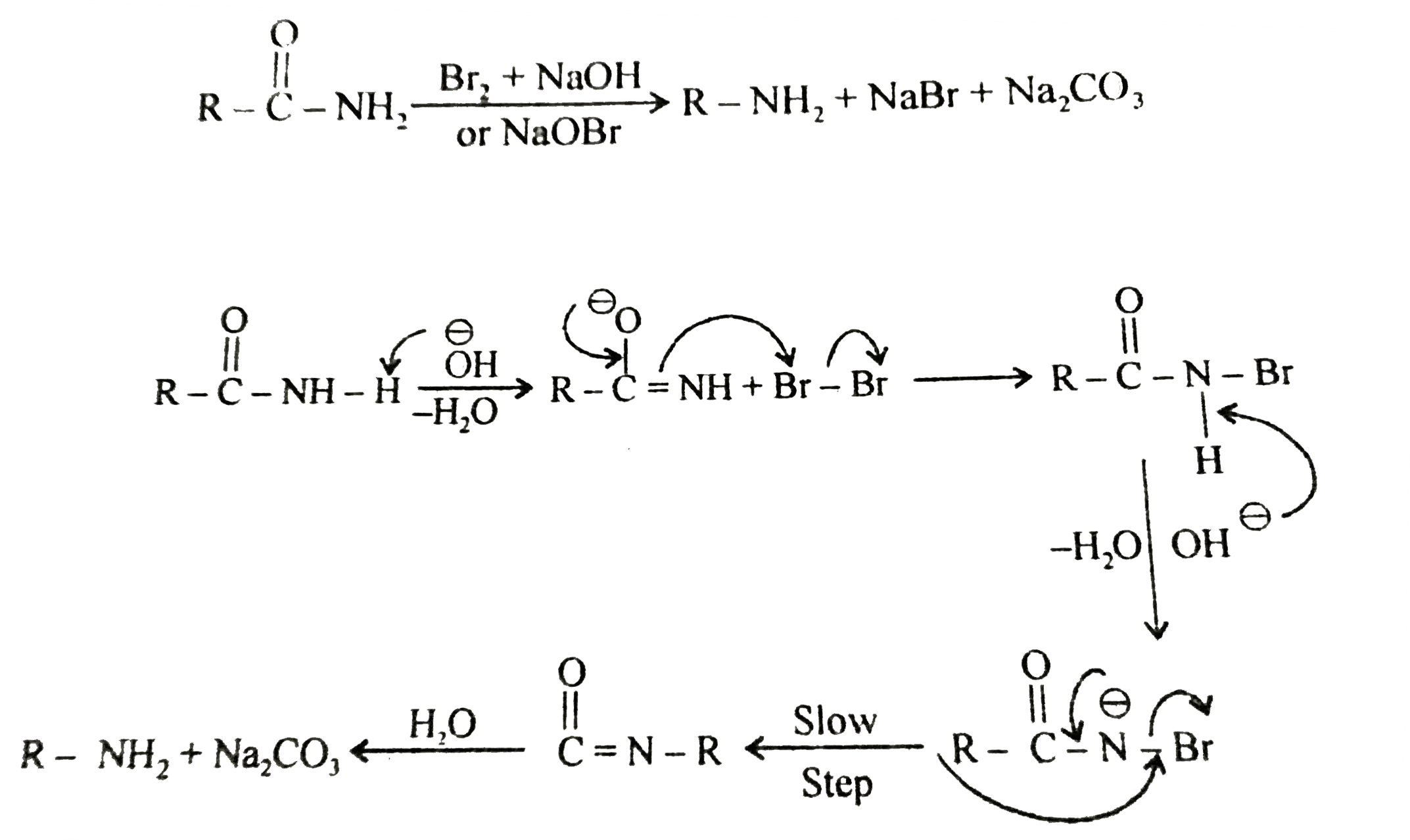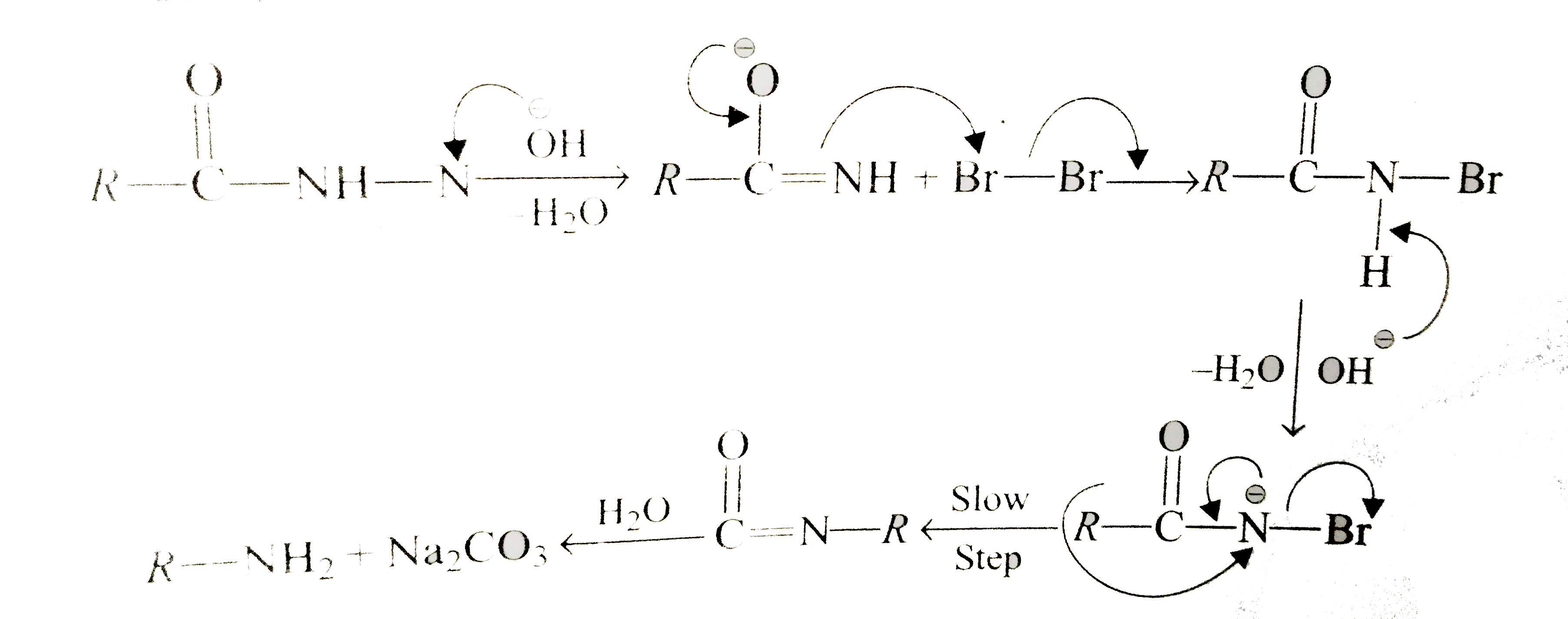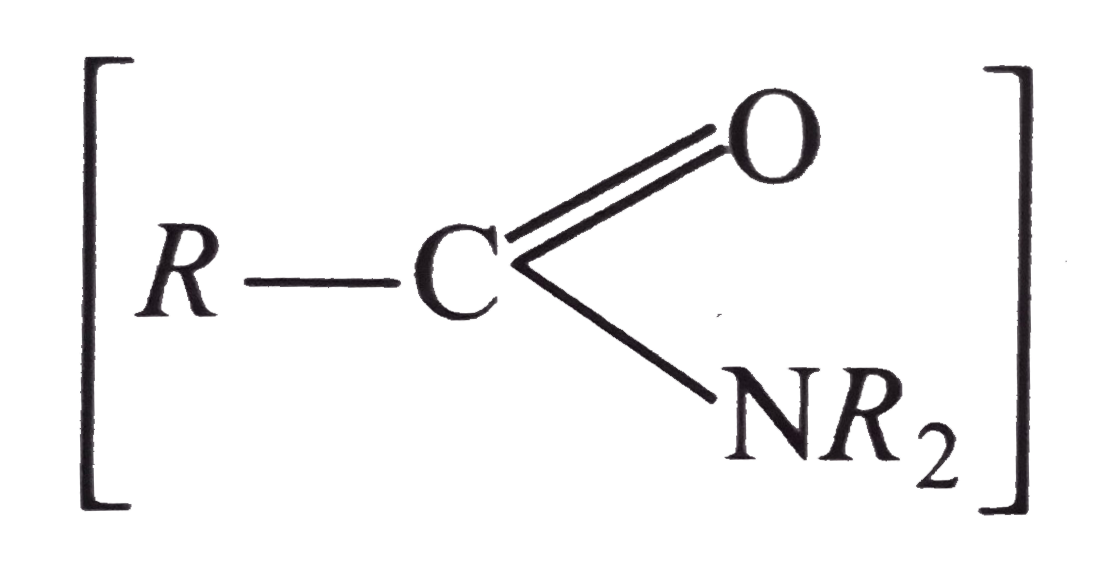Number of moles of NaOH used in above Hoffmann bromamide reaction is :
3
4
5
6
The correct Answer is:B
(b) Balanced reaction is
Topper's Solved these Questions
- CARBENE AND NITRENEBOOK - MS CHOUHANCHAPTER - CARBENE AND NITRENEEXERCISE - Level 1 (Q.31 To Q.41)
11 Videos
- CARBENE AND NITRENEBOOK - MS CHOUHANCHAPTER - CARBENE AND NITRENEEXERCISE - Level 2
24 Videos
- CARBENE AND NITRENEBOOK - MS CHOUHANCHAPTER - CARBENE AND NITRENEEXERCISE - Level 2
24 Videos
- CARBENE AND CARBENOIDSBOOK - MS CHOUHANCHAPTER - CARBENE AND CARBENOIDSEXERCISE - ADDITIONAL OBJECTIVE QUESTIONS (Single Correct Choice Type)
26 Videos
- CARBOHYDRATES BOOK - MS CHOUHANCHAPTER - CARBOHYDRATES EXERCISE - MULTIPLE CORRECT CHOICE TYPE (INTEGER TYPE)
1 Videos
Similar Questions
Amides with no substitution on nitrogen react with tht: solution of bromine or chlorine in NaOH or KOH to yield aminei through a reaction called as Hofmann's degradation.
R−O∣∣C−NH2+Br2+4NaOHH2O−−→R−NH2+2NaBr+Na2CO3+2H2O
Amides can be reduced to amines having same number of carbon atoms
R−O∣∣C−NH2−[H]−−−→LiAlH4R−CH2−NH2
Benzamide when treated with Br2 in presence of NaOH gives aniline.
View SolutionAmides with no substitution on nitrogen react with tht: solution of bromine or chlorine in NaOH or KOH to yield aminei through a reaction called as Hofmann's degradation.
R−O∣∣C−NH2+Br2+4NaOHH2O−−→R−NH2+2NaBr+Na2CO3+2H2O
Amides can be reduced to amines having same number of carbon atoms
R−O∣∣C−NH2−[H]−−−→LiAlH4R−CH2−NH2
Carbon dioxide gas is released in above mentioned reaction
View Solution
Knowledge Check
R−O∣∣C−NH2+xNaOH+Br2→R−NH2+2NaBr+Na2CO3+H2O
Number of moles of NaOH used in above Hoffmann bromamide reaction is :A3B4C5D6The conversion of an amide by action of NaOH andBr2 to primary amine that has one carbon less than
the starting amide is known as Hofmann-Bromamide reaction.
R−O∣∣C−NH2Br2+NaOH−−−−−−−→or NaOBrR−NH2+NaBr+Na2CO3

Number of moles of NaOH consumed in a above reaction :A1B2C3D4The conversion of an amide by reaction NaOH and Br2 to primary amine that has one carbon than the strating amide is known as Hofmann-Bromoamide reaction.
R−O∣∣C−NH2Br2+NaOH−−−−−−−→orNaOBrR−NH2+NaBr+Na2CO3
Mechanism:

Number of moles of NaOH consumed in above reaction:A1B2C3D4
Amides with no substitution on nitrogen react with tht: solution of bromine or chlorine in NaOH or KOH to yield aminei through a reaction called as Hofmann's degradation.
R−O∣∣C−NH2+Br2+4NaOHH2O−−→R−NH2+2NaBr+Na2CO3+2H2O
Amides can be reduced to amines having same number of carbon atoms
R−O∣∣C−NH2−[H]−−−→LiAlH4R−CH2−NH2
N-Methyl aniline can be obtained by using Hofmann's degradation.
View SolutionAmides with no substitution on nitrogen react with tht: solution of bromine or chlorine in NaOH or KOH to yield aminei through a reaction called as Hofmann's degradation.
R−O∣∣C−NH2+Br2+4NaOHH2O−−→R−NH2+2NaBr+Na2CO3+2H2O
Amides can be reduced to amines having same number of carbon atoms
R−O∣∣C−NH2−[H]−−−→LiAlH4R−CH2−NH2
 will undergo Hofmann's degradation.
will undergo Hofmann's degradation.
View SolutionAmides with no substitution on nitrogen react with tht: solution of bromine or chlorine in NaOH or KOH to yield aminei through a reaction called as Hofmann's degradation.
R−O∣∣C−NH2+Br2+4NaOHH2O−−→R−NH2+2NaBr+Na2CO3+2H2O
Amides can be reduced to amines having same number of carbon atoms
R−O∣∣C−NH2−[H]−−−→LiAlH4R−CH2−NH2
Iso-cyanates are formed as intermediate in the Hofmann's degradation.
View SolutionRCONH2+4NaOH+Br2→RNH2+2NaBr+Na2CO3+2H2O Reaction is said
View SolutionRCONH2+4NaOH+Br2→RNH2+2NaBr+Na2CO3+2H2O Reaction is said
View Solution
